Acer Aspire 5 review (A515-57 model – a fair budget laptop)
This is my review of the Acer Aspire 5 budget laptop, in a mid-tier well-balanced A515-57G configuration that bundles an Intel i7 processor with Nvidia MX550 graphics and an IPS screen.
These are quite capable specs for an affordable laptop that I bought for around 700 EUR, especially with the thermal module being able to properly cool the hardware in this chassis.
In fact, this Aspire 5 covers the basics very well and should suit most needs for daily use, medium school/office, and some casual gaming in your spare time. At the same time, it is nonetheless a budget-level laptop series, so don’t expect much in terms of fancy features, premium materials, or display and audio quality.
The review down below gathers all my impressions of this series, with the positives and the quirks that you should be aware of when looking at one of these.
Specs as reviewed– Acer Aspire 5 A515-57
Acer Aspire 5 A515-57G, 2022 model
Screen
15.6 inch, IPS, matte, non-touch
16:9 format, 1920 x 1080 px resolution, 60 Hz refresh
Processor
Intel C0re i7-1255U, 2PC + 8Ec/12T (up to 4.7 GHz Turbo)
Video
Integrated Iris Xe Graphics + Nvidia MX550 2GB (30W)
Memory
8 GB DDR4-3200 (2x DIMMs)
Storage
512 GB M.2 SSD (Micron 2450) – two M.2 2280 slots
Connectivity
Mediatek Wifi 6 (MT7921) with Bluetooth 5.2
Ports
3x USB-A 3.2 gen1, 1x USB-C 3.2 with Thunderbolt 4 (with DP and Powder Delivery), HDMI 2.1, LAN, headphone/mic jack, Kensington Lock
Battery
50 Wh, 65W charger with barrel-plug (USB-C charging also possible)
Size
362 mm or 14.25” (w) x 237 mm or 9.33” (d) x 17.9 mm or .7” (h)
Weight
1.8 kg (3.95 lbs) + .27 kg (.58 lbs) for the charger, EU version
Extras
white lit keyboard with NumPad, HD camera, fingerprint reader in the clickpad, bottom-firing stereo speakers, available in two colors – gold and gray
You can get this in multiple hardware configurations, with up to 12th-gen Alder Lake Core U or Core P processors, 16 GB of RAM, and RTX 2050 graphics.
Variants with integrated Iris Xe graphics are also available, on either Core U or Core P platforms, and we’ve reviewed one as well and we’ll discuss it in the article.
Design and ergonomics
As mentioned, the Aspire 5 is a basic laptop design, but on par with today’s expectations and demands.
That means it’s fairly compact and lightweight for a full-size laptop, at around 1.8 kg, and is built well, with only some flex in the middle of the chassis and almost none on the lid and screen ensemble. I also haven’t noticed any funny noises or other issues when grabbing this along during my daily commute, or even when picking it up from a corner.

In fact, the lid is made of aluminum on this series, available in either a Silver or a Golden variant (the one we have here), while the rest of the case is entirely made out of plastic, with a silver color scheme. This mix of colors is a bit odd, but not a deal-breaker by any means. It’s also fairly practical, easily hiding smudges and fingerprints.
Plastic is used for the bezels around the screen as well, which are not as thin as on more premium designs, but still, within acceptable limits – there’s a picture below of the Aspire 5 and the Acer Swift Edge series side by side, to help you understand the differences between this sort of design and more portable ultra-light model.
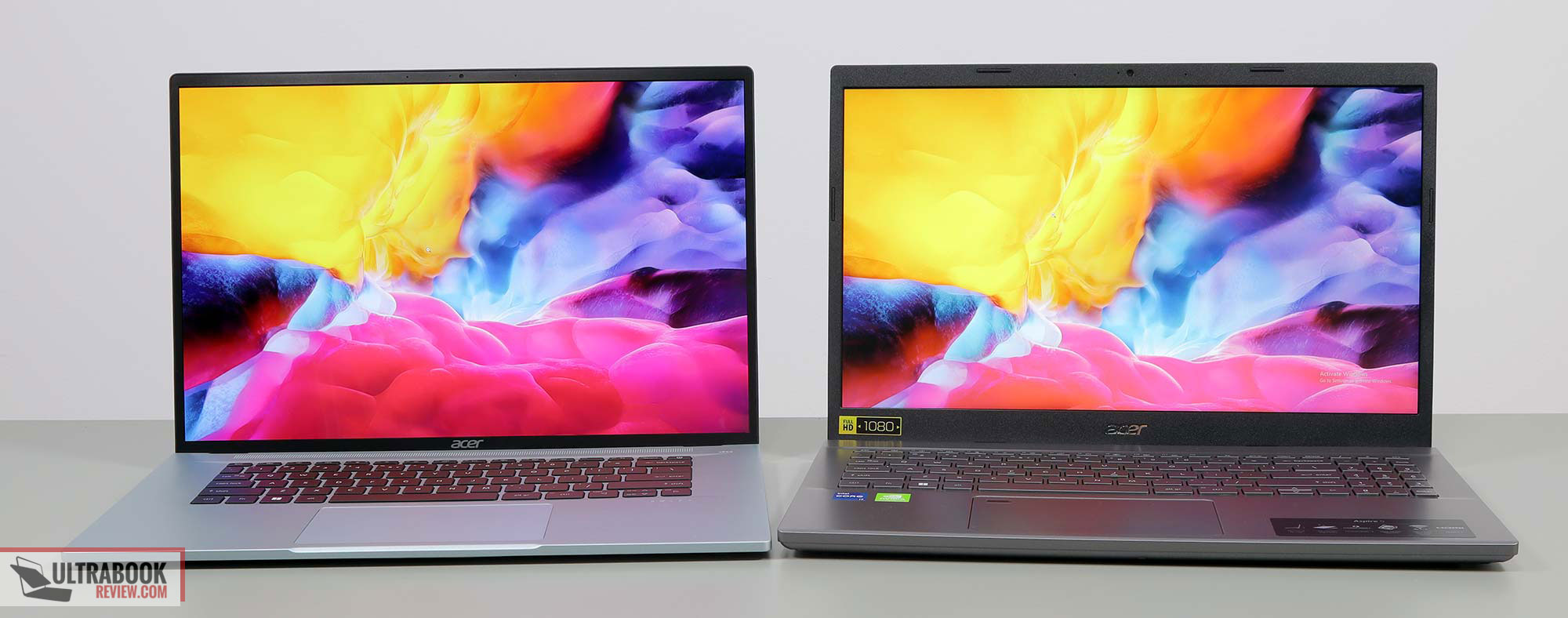
In fact, the chin underneath the display is actually practical here, as it soaks up most of the heat coming out from the exhaust radiator placed just under the screen, and thus it prevents the panel from overheating.
As far as ergonomics go, this sits stably on the desk thanks to the grippy rubber feet on the underbelly, despite their small size. Acer also blunted the front lips and corners, so they’re comfortable on the wrists.
The two hinges do a good job at stabilizing the display without it moving or wobbling during daily use, but on the other hand, they’re rather stiff so you will need both hands to open up this notebook. BTW, the laptop is designed to lift up on some small rubber feet placed at the bottom of the screen part, in order to allow for better airflow underneath the chassis and into the fans. The screen only leans back to about 155 degrees, and not all the way flat.
The IO is lined around the edges, with most of the ports conveniently placed on the left side.
Aside from a card reader, there’s everything you’ll want here, including a LAN port, a full-size HDMI, multiple USB-A ports, and a USB-C port with full Thunderbolt 4 support. That means this laptop can charge via USB-C, if you don’t want to use the included barrel-plug charger.
Keyboard and trackpad
The inputs here are standard for an Acer laptop, with a full-size keyboard with a NumPad section and a spacious clickpad underneath.
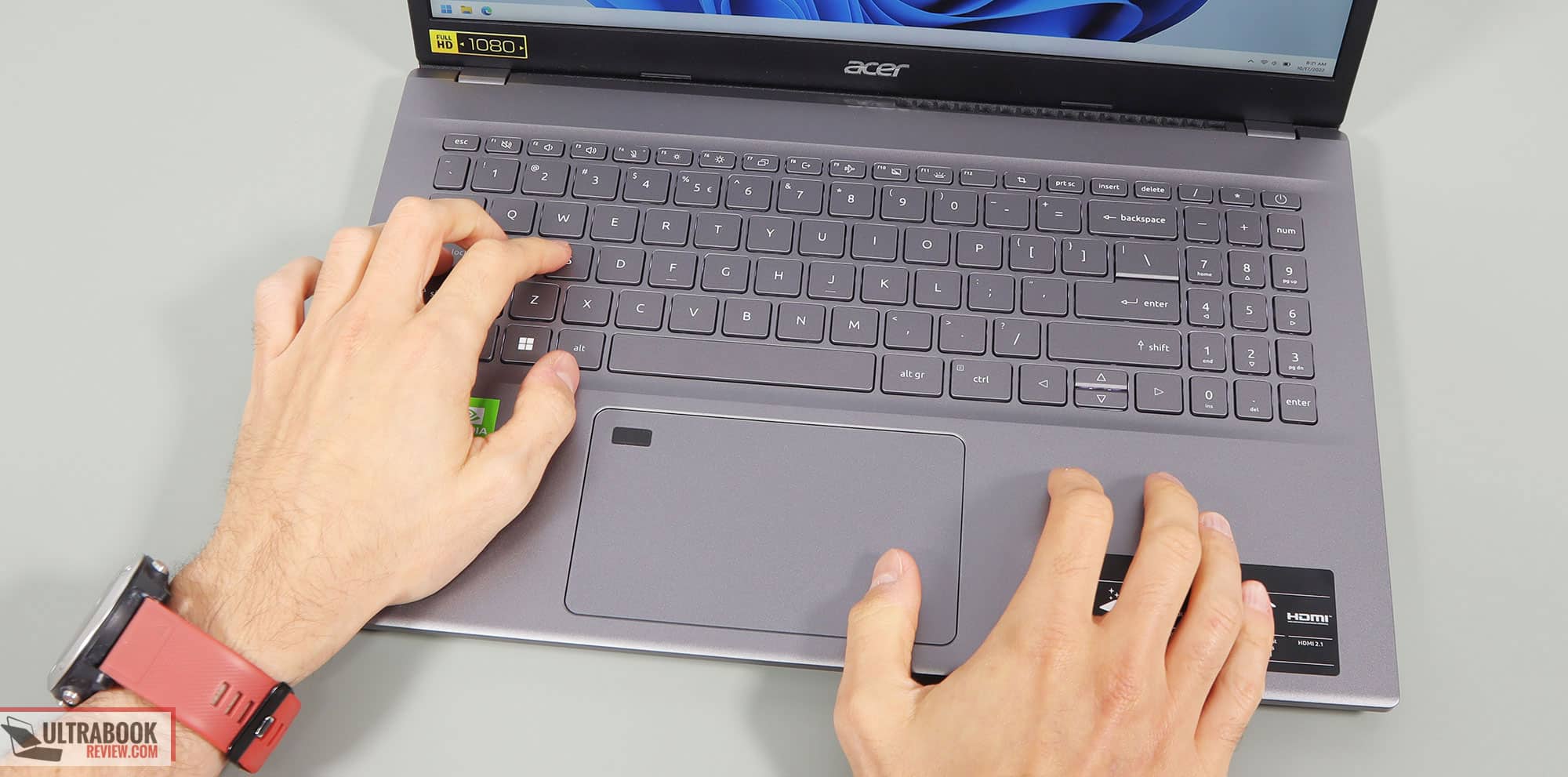
Acer went for smooth plastic keycaps that color match the silver chassis, and that helps them hide smudges and finger oil. The overall typing experience is fine, a little on the mushier side, but overall it is what I’d expect from a laptop in this class in 2022.
The flex in the chassis will take some time to get used to, but it doesn’t impact the typing accuracy or overall feedback in a significant way.
Acer also implemented white backlighting for the keys, but that is optional and not available in some of the lower-tier configurations. Once more, it’s a standard Acer implementation with some slight variations in lighting uniformity, but fine overall. You’ll have to physically press a key to bring back the lights once they time out.
The clickpad is spacious and slightly indented from the armrest around. It’s a plastic surface and not as smooth to the touch as the glass clickpads out there, but it tracks well and handled all the right gestures and swipes during my time with this laptop.
It does feel a little wonky with taps, and I found the physical clicks to be stiff and somewhat difficult to use.
I’ll also mention that there’s a finger sensor integrated into the top-left corner of the clickpad. I prefer stand-alone or power-button readers instead, but this one seems to work fine with Windows Hello and doesn’t create a blind spot when gliding your finger over it.
Screen
Acer offers a standard 15.6-inch 16:9 matte display on this Aspire 5 series, with a barely acceptable IPS panel for a 2022 laptop.
If you’re coming from an older laptop or don’t expect much in terms of color quality, I guess this will do OK for you. For me, though, it’s hard to accept this with the dim brightness and washed-out colors. In fact, this screen is pretty much the single most important potential deal-breaker that you must account for when looking at this laptop series.
Here’s what we got in our tests, with an X-Rite i1 Display Pro sensor:
- Panel HardwareID: Chi Mei CMN15E7 (N156HCA-EAB);
- Coverage: 64.1% sRGB, 44.4% AdobeRGB, 45.6% DCI P3;
- Measured gamma: 2.25;
- Max brightness in the middle of the screen: 372.82 cd/m2 on power;
- Min brightness in the middle of the screen: 21.58 cd/m2 on power;
- Contrast at max brightness: 1399:1;
- White point: 7100 K;
- Black on max brightness: 0.19 cd/m2;
- PWM: No (to be further tested).
As mentioned, this panel doesn’t get either very bright (for outdoor use) or very dim (for dark-room use). At the same time, colors are barely adequate at 64% sRGB gamut coverage, but the viewing angles are OK and the contrast and blacks are better than expected.
You’ll want to calibrate this to fix the Gammty and White point as much as possible. Once calibrated, this panel ended up uniformly lit and I also haven’t noticed any bad light bleeding around the edges.
One final aspect worth covering here is the fact that this is a 60 Hz panel with slow-response times, so if you’re planning on running games more often than not on your computer, you should spend a little more for something with a faster and higher-fresh display (and more powerful specs, at the same time).
Hardware and performance
Our test model is a mid-specced configuration of the 2022 Acer Aspire 5, code name A515-57G, with an Intel Core i7-1255U processor and Nvidia MX550 2GB graphics, 8 GB of DDR4-3200 memory, and a middling 512 GB gen3 SSD.
Disclaimer: I bought this unit locally as I was looking for a budget daily driver for a family member. I tested it with the software available as of mid-October 2022 (BIOS 1.15, Care Center 4.00.3042 app). Some aspects might still change with future software updates.
However, I’ve also reviewed an Intel Core i3-1220P + Iris Xe variant of the laptop (received from Acer), and will mention the findings down below as well, in case you’re interested in a configuration without a dGPU.
Spec-wise, this is based on the 2022 Intel 12th-gen Alder Lake Core U hardware platform. The Core i7-1255U is a hybrid design with 2 Performance and 8 Efficiency Cores, as well as 12 combined threads. This 15-inch implementation supplies the CPU with 28+W of sustained power in demanding loads, allowing it to perform better than in more portable and lower-power designs.
Graphics are handled by the Nvidia MX550 graphics chip on our unit, an entry-level dGPU based on the 12nm Turing TU117 graphics cores. It offers 1024 shaders and 2 GB of GDDR6 memory in this variant, and runs at 30W of power. iGPUs-only and an RTX 2050 dGPU are also options for this series.
Our configuration also comes with 8 GB of DDR4-3200 memory, with two 4GB sticks in dual-channel. The memory can be easily upgraded, and 16 GB (2x 8 GB) configurations are also available in stores.
For storage, Acer opted for a middling PCIe gen3 Micron 2450 drive here, but gen4 SSDs are also supported, in case you might want to upgrade it. Two M.2 2280 slots are available inside.
It is possible to open up this device to get to the internals, and it’s a basic task, requiring you to remove the back panel held in place by a few Philips screws. Inside you’ll find the RAM, SSD, and WiFi slots, as well as the thermal module, battery, and speakers. The image below is from the Core P tested unit, without a dGPU, and with two SSDs.
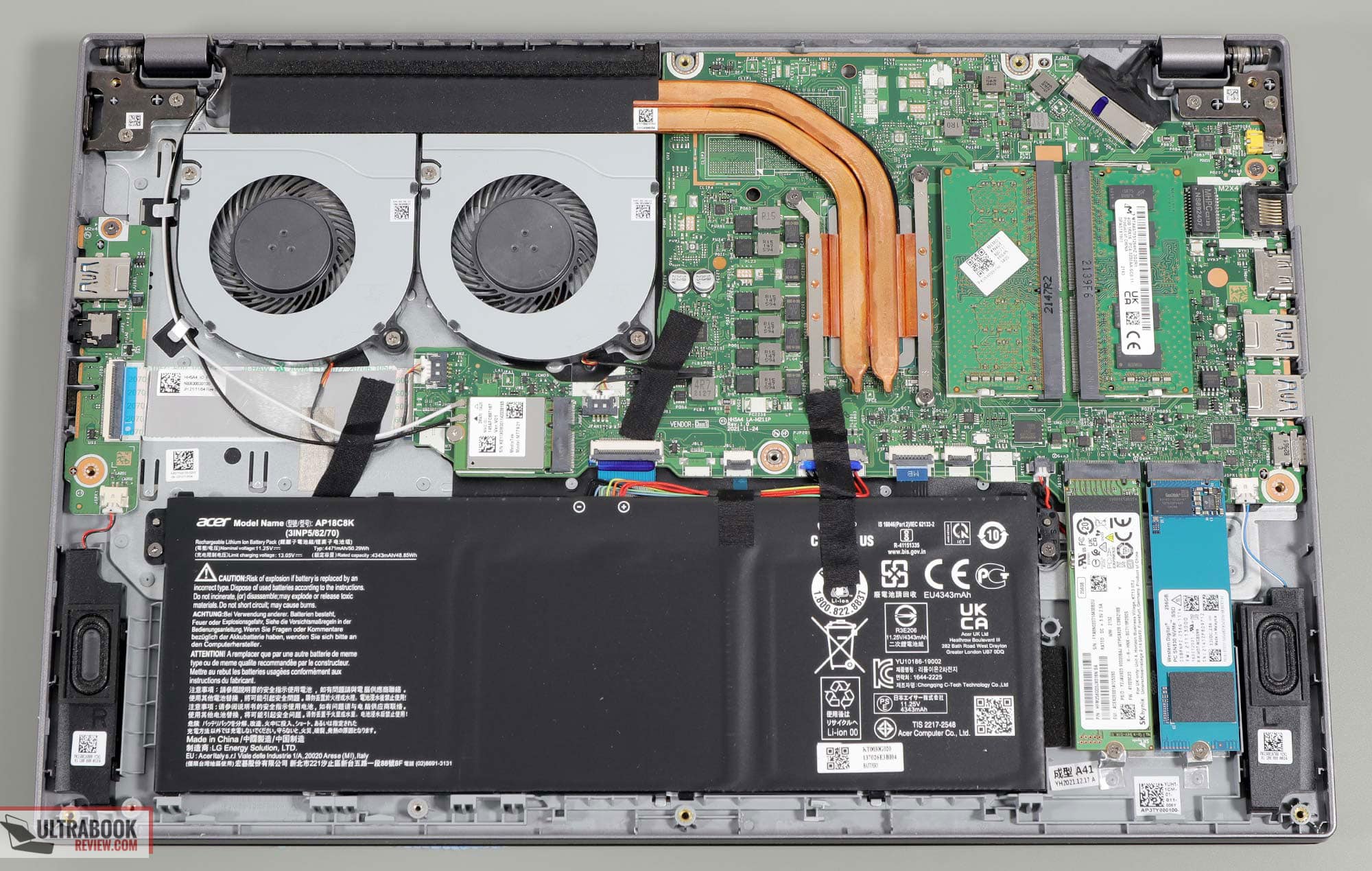
As far as the software goes, I put a fresh install of Windows 11 on my unit, with only the basic Acer apps from the site, which means I didn’t have to deal with any of the bloatware that normally comes preinstalled with Acer laptops.
Acer still don’t offer any sort of control software with different power modes for these devices, unlike all the other OEMs. That means you’ll have to rely on the power modes in Windows 11, and I’ve used the laptop on Best Performance when plugged in and on Best Power Efficiency when unplugged.
Here’s what to expect in terms of speeds and temperatures with daily multitasking and light use.
Performance and benchmarks
On to more demanding loads, we start by testing the CPU’s performance in the Cinebench R15 loop test.
We’ve tested two variants of this laptop, one with a Core i7-1255U and another with a Core i3-1220P, and both performed identically. The system allows for peak PL2 power of 55W for a brief moment, and then 28W of sustained PL1 power in this test, for both processors.
The fans ramp up to about 40 dBA at 55W and then stabilize at sub 35dB at 28W, while the temperatures stabilize at around 65 degrees Celsius. Both are excellent results, and suggest Acer could even allow a higher sustained power setting for this sort of demanding CPU activity. That would come in handy if you opt for a Core i5-1240P or i7-1260P configuration, with the 4PC+8Ec hybrid design.
On battery power, our sample ran stably at 15W, with much briefer bursts to higher-power settings. Hence, the performance on battery power is not quite on par with what you’ll get with this device when plugged in. All these are illustrated in the graph below.
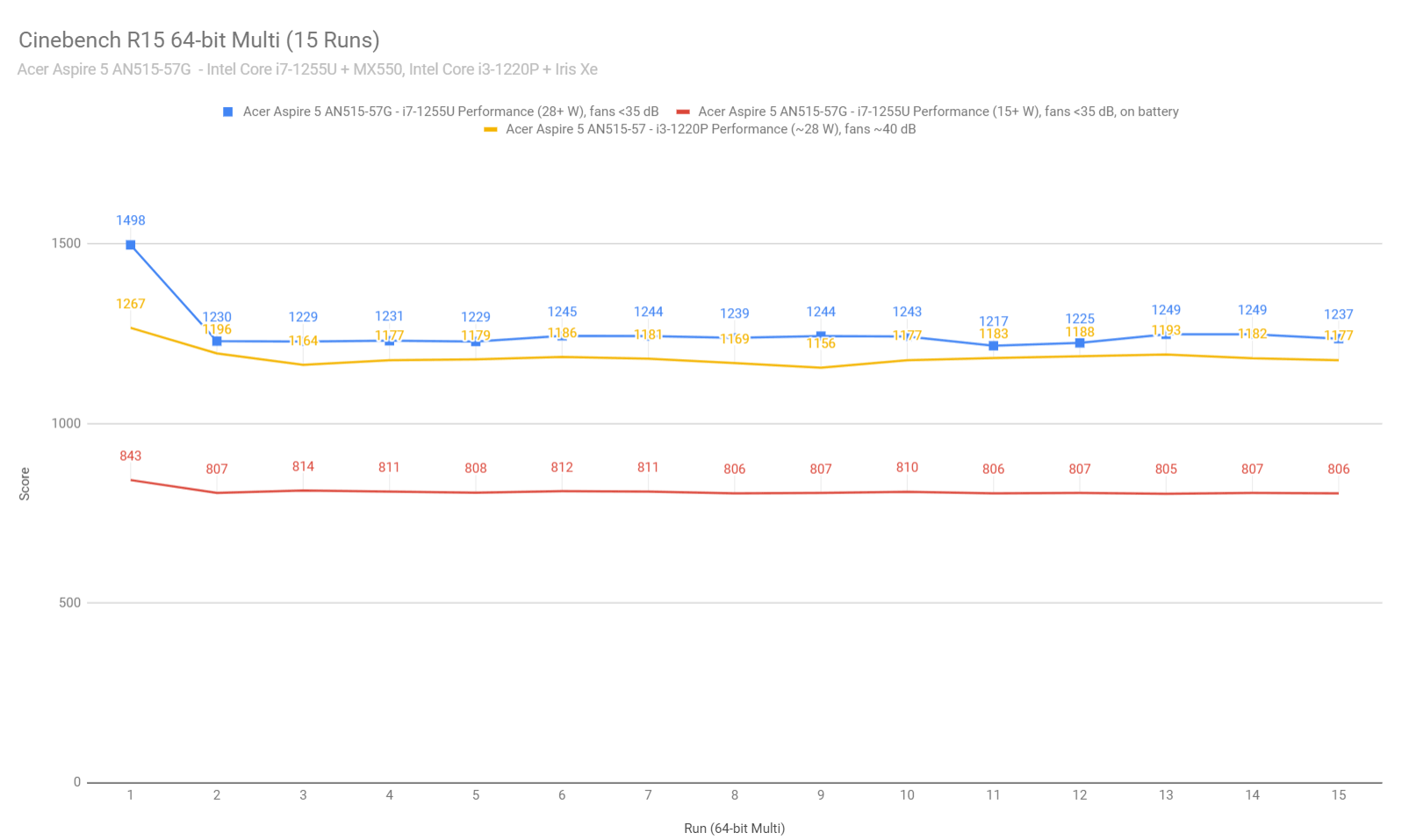
To put these in perspective, here’s how this i7-1255U implementation fares against other hardware platforms available in similar kinds of laptops. The extra cores in the AMD platforms allow them to outperform in this sustained multi-threaded load, but the Intel models have an advantage in daily use with the superior IPC and clock speeds, as we’ll see further down.
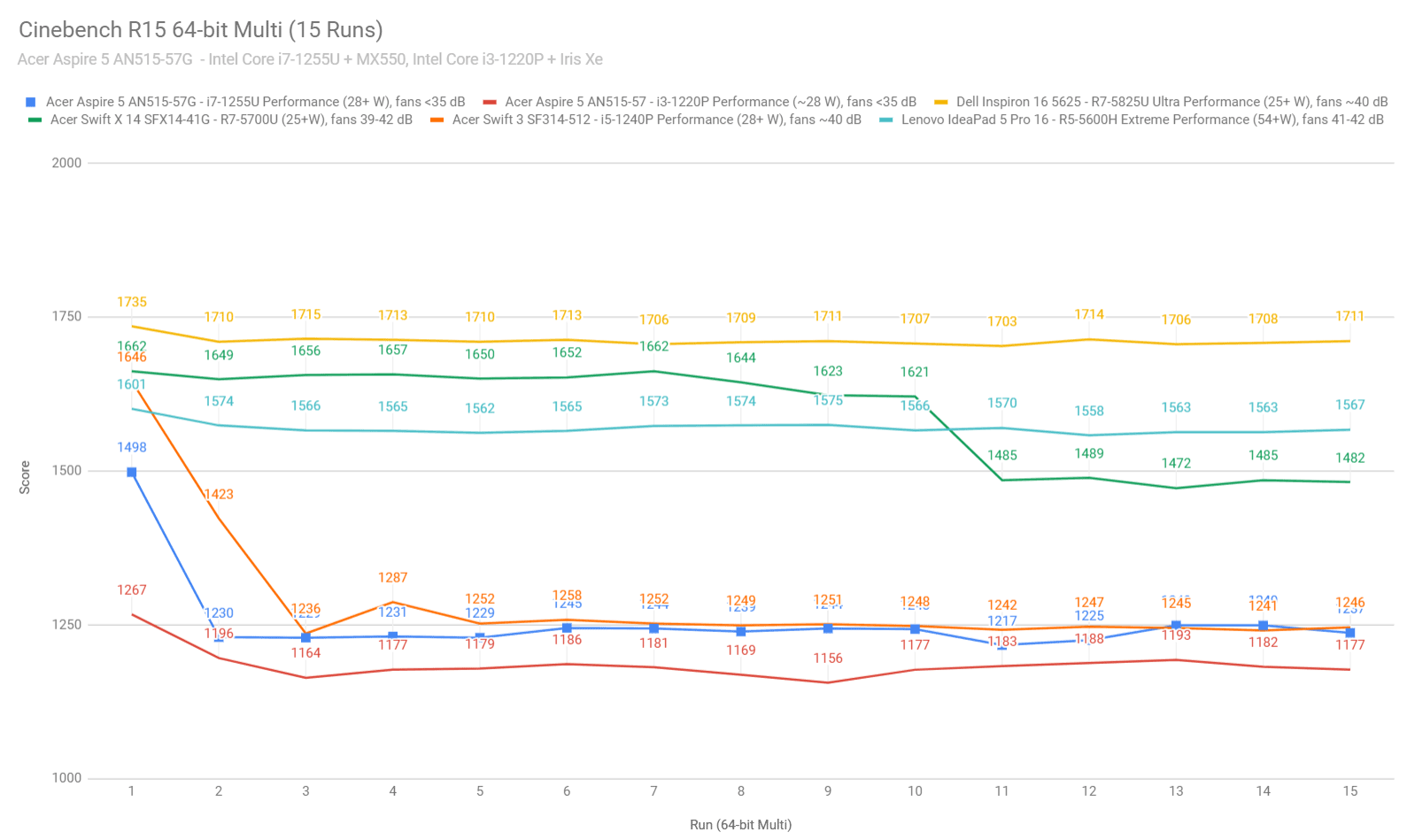
We then went ahead and further verified our findings with the more taxing Cinebench R23 loop test and in Blender, confirming our above findings.
We then ran the 3DMark CPU profile test.
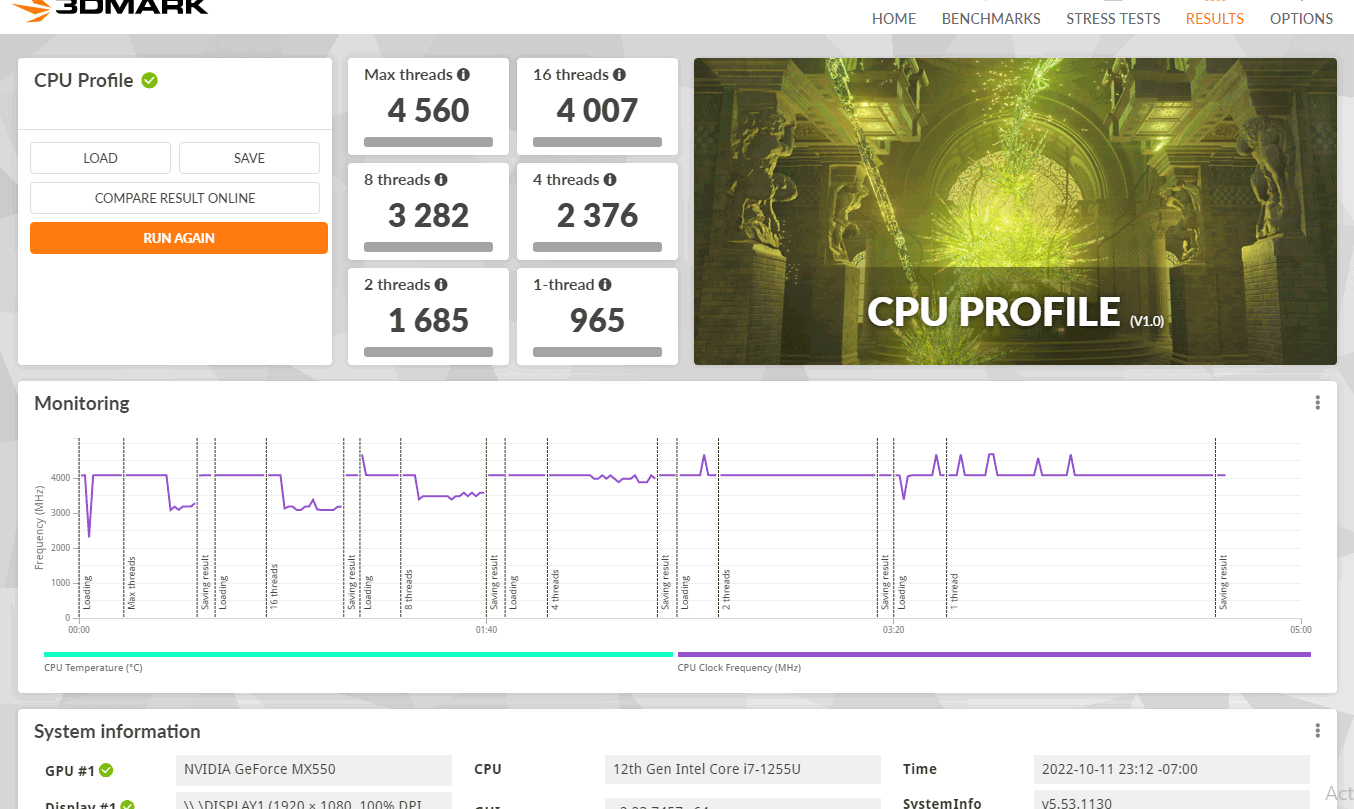
Finally, we ran our combined CPU+GPU stress tests on this notebook, on the Best Performance profile. 3DMark stress runs the same test for 20 times in a loop and looks for performance variation and degradation over time, and both configurations were able to pass it, which means the performance does not degrade and the hardware does not overheat with longer loads.
Next, here are some benchmark results. We ran the entire suite of tests and benchmarks on the Best Performance profile in Windows 11 on this Core i7-1255U + MX550 configuration, with the screen set at the default FHD resolution.
Here’s what we got.
- 3DMark 13 – Fire Strike: 5702 (Graphics – 6205, Physics – 11271, Combined – 2428);
- 3DMark 13 – Night Raid: 22654 (Graphics – 32751, CPU – 8247);
- 3DMark 13 – Time Spy: 2667 (Graphics – 2502, CPU – 4265);
- Uniengine Superposition – 1080p Extreme: 983;
- Uniengine Superposition – 1080p Medium: 4886;
- Handbrake 1.3.3 (4K to 1080p encode): 36.42 average fps;
- PassMark 10: 4247 (CPU – 16587, 3D – 2355, Memory – 5220, Disk – 23567);
- PCMark 10: 5857 (Essentials – 9710, Productivity – 8355, Digital Content Creation – 6722);
- GeekBench 5.4.3 64-bit: Single-Core: 1683, Multi-core: 7453;
- CineBench R15 (best run): CPU 1508 cb, CPU Single Core 253 cb;
- CineBench R20 (best run): CPU 3154 cb, CPU Single Core 668 cb;
- CineBench R23: CPU 8362 cb (best run), CPU 7936 (10 min loop test), CPU Single Core 1750 CB (best run);
- x265 HD Benchmark 64-bit: 45.66 s.
And here are some work-related benchmarks:
- Blender 3.01 – BMW scene – CPU Compute: 5m 10s;
- Blender 3.01 – Classroom scene – CPU Compute: 12m 41s;
PugetBench – DaVinci Resolve: 430; - PugetBench – Adobe Photoshop: 554;
- PugetBench – Adobe Premiere: crashed;
- SPECviewperf 2020 – 3DSMax: 18.02 ;
- SPECviewperf 2020 – Catia: 18.91;
- SPECviewperf 2020 – Creo: 43.07;
- SPECviewperf 2020 – Energy: 0.62;
- SPECviewperf 2020 – Maya: 110.79;
- SPECviewperf 2020 – Medical: 12.22;
- SPECviewperf 2020 – SNX: 11.15;
- SPECviewperf 2020 – SW: 58.52;
- V-Ray Benchmark: CPU – 5039 vsamples, GPU CUDA – 140 vpaths;
These are some competitive results.
On the CPU side, sure, this isn’t as fast in multi-threaded loads as the 12th-gen Core P or the current Ryzen U platforms, but is still fast enough for everyday use and multitasking and even some occasional workloads such as Photoshop.
On the GPU side, the MX550 is only 10-20% slower than an RTX 1650 35W of the past years, but much slower than an RTX 3050/3050Ti at similar power.
At the same time, the MX550 trades blows with the Radeon 680M graphics in the AMD Ryzen 6000 processors and is faster compared to the lower-power configurations of the AMD Ryzen specs, such as the Zephyrus S 13. Plus, it’s 25-50% faster than the Intel Iris Xe graphics available in the Core U and Core P configurations, based on the power settings of each implementation.
In fact, Acer also offers the laptop in Core P or Core U variants with Iris Xe graphics, without a dGPU. If interested in one of those, here’s what to expect in terms of performance on the i7-1255U + Iris Xe model (we measured these by disabling the MX550 on this review unit).
- 3DMark 13 – Fire Strike: 3616 (Graphics – 3893, Physics – 18571, Combined – 1320);
- 3DMark 13 – Night Raid: 14260 (Graphics – 16474, CPU – 8097);
- 3DMark 13 – Time Spy: 1530 (Graphics – 1357, CPU – 5533);
- Uniengine Superposition – 1080p Extreme: 781;
- Uniengine Superposition – 1080p Medium: 2042;
- PassMark 10: 4365 (CPU – 16682, 3D – 2830, Memory – 2599, Disk – 23011);
- PCMark 10: 5508 (Essentials – 10435, Productivity – 7025, Digital Content Creation – 6187);
- PugetBench – Adobe Photoshop: 557;
- PugetBench – Adobe Premiere: 187;
- V-Ray Benchmark: CPU – 5223 vsamples, GPU CUDA – 140 vpaths;
These are excellent results for an Intel U implementation, thanks to the high sustained power settings possible in this chassis.
Back to our i7 + MX550 unit, as far as gaming performance goes, you can run most simpler or older games on this device, at FHD resolution and Low/Medium settings.
Here’s what to expect on Low settings compared to a few iGPU models and the GTX 1650 35+W version of the Acer Swift X14.
Low settings
Acer Aspire 5 –
i7-1255U, MX550 30W,
FHD 1080p
ZenBook 14 2022 –
i7-1260p, Iris Xe,
30+W, FHD+ 1200p
ZenBook S 13 2022 –
R7-6800U, Radeon,
15+W, FHD 1200p
ZenBook 14 2021 –
i7-1165G7, Iris Xe,
19+W, FHD 1080p
Swift X 14 –
Ryzen 7, 1650 35W,
FHD resolution
Bioshock Infinite
(DX 11, Low Preset)
167 fps (117 fps – 1% low)
70 fps (48 fps – 1% low)
102 fps (63 fps – 1% low)
70 fps (40 fps – 1% low)
142 fps (103 fps – 1% low)
Doom: Eternal
(Vulkan, Medium Preset)
55 fps (45 fps – 1% low)
29 fps (15 fps – 1% low)
45 fps (34 fps – 1% low)
–
–
Far Cry 5
(DX11, Low Preset)
61 fps (48 fps – 1% low)
29 fps (15 fps – 1% low)
45 fps (34 fps – 1% low)
–
–
Dota 2
(DX 11, Best Looking Preset)
94 fps (50 fps – 1% low)
76 fps (52 fps – 1% low)
74 fps (46 fps – 1% low)
56 fps (44 fps – 1% low)
84 fps (44 fps – 1% low)
Shadow of Tomb Raider
(DX12, Lowest Preset, no AA)
70 fps (43 fps – 1% low)
36 fps (23 fps – 1% low)
47 fps (35 fps – 1% low)
28 fps (16 fps – 1% low)
64 fps (36 fps – 1% low)
The Witcher 3: Wild Hunt
(DX 11, Low Preset, Hairworks Off)
71 fps (48 fps – 1% low)
38 fps (20 fps – 1% low)
41 fps (26 fps – 1% low)
–
73 fps (60 fps – 1% low)
- Doom, Dota 2, Witcher 3 – recorded with MSI Afterburner in game mode;
- Bioshock, Tomb Raider games – recorded with the included Benchmark utilities;
And here’s what to expect on Medium compared to a few iGPU and lower-level dGPU configurations.
Medium settings
Acer Aspire 5 –
i7-1255U + MX550 30W
FHD resolution
Zephyrus G14 2022 –
R9 + Radeon 680M
FHD+ resolution
ZenBook 14X –
Core i9 + Iris Xe
FHD+ resolution
XPS 15 –
Core i7 + 3050Ti 35+W
FHD+ resolution
Far Cry 5
(DX 11, Normal Preset, TAA)
48 fps (36 fps – 1% low)
43 fps (38 fps – 1% low)
33 fps (29 fps – 1% low)
72 fps (54 fps – 1% low)
Shadow of Tomb Raider
(DX 12, Medium Preset, TAA)
42 fps (27 fps – 1% low)
35 fps (24 fps – 1% low)
24 fps (17 fps – 1% low)
52 fps (26 fps – 1% low)
The Witcher 3: Wild Hunt
(DX 11, Medium Preset, Hairworks Low)
62 fps (42 fps – 1% low)
47 fps (34 fps – 1% low)
40 fps (22 fps – 1% low)
92 fps (59 fps – 1% low)
Bottom point, yes, you can run some games on this laptop and you’re getting better performance than on ultraportables designs with only iGPUs graphics, but if gaming is important for you, I’d suggest opting for a more powerful laptop with a faster display.
With that out of the way, the performance logs down below show the CPU/GPU clocks and temperatures in a couple of games.
On the i7-1255U + MX550 configuration, the CPU runs at 10-15W of power, and the GPU at 28-30W, right at the design power limit. Temperatures stay within mid-60s to mid-70s on the CPU, and mid to high 60s on the GPU, with the laptop sitting on the desk.
On the Intel i7-1255U + Iris Xe or the Intel Core i3-1220P + Iris Xe configurations without a dGPU, the CPU package runs at 28W sustained (or lower in the less demanding titles), with temperatures in the 50 or 60s.
The fans ramp up to 40 dBA on the Best Performance profile on all models.
Running games on battery power is possible as well, with the MX550 GPU slightly limited at 25W in this case.
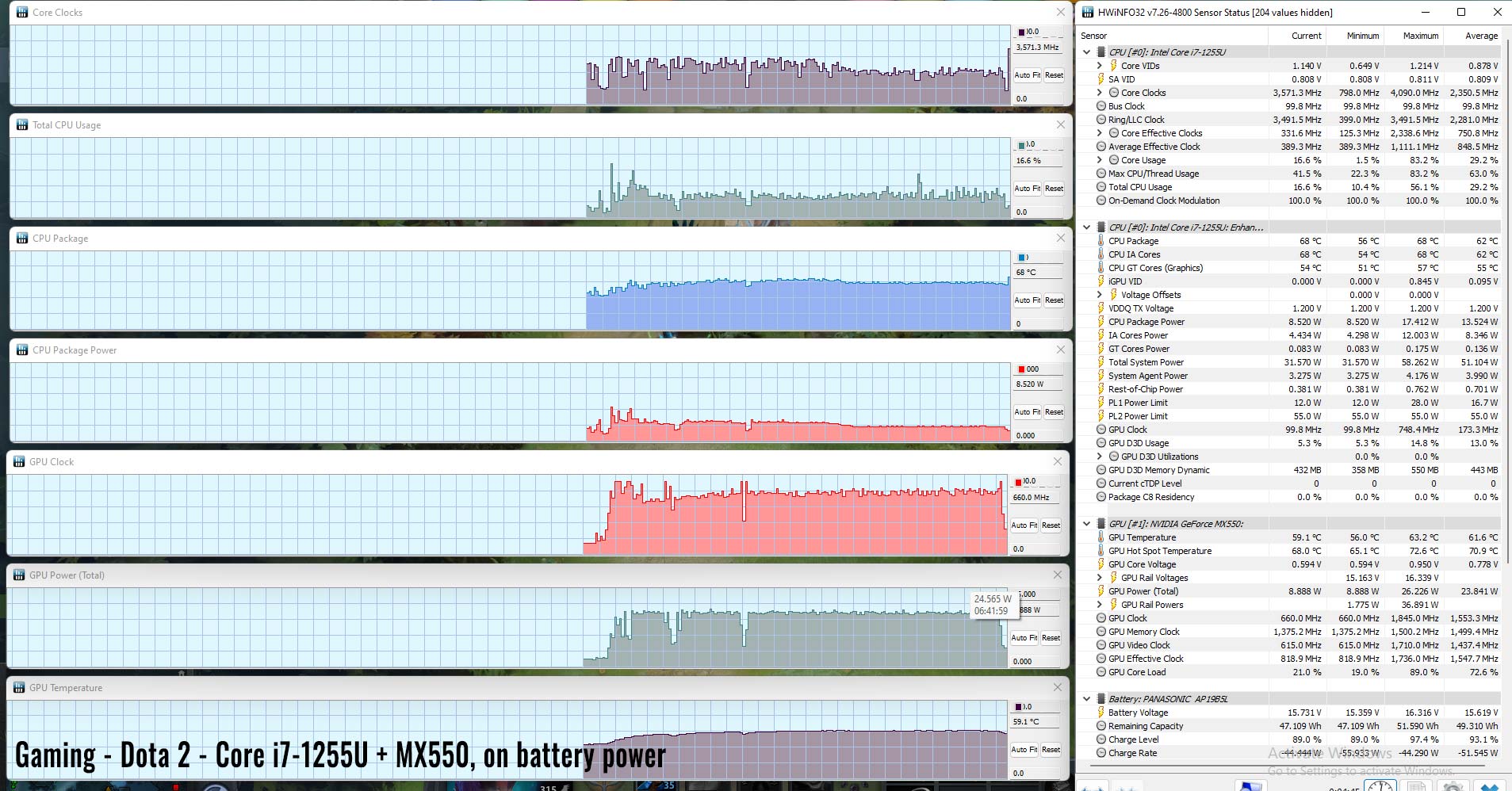
Noise, Heat, Connectivity, speakers, and others
Acer puts a mid-level thermal module on this laptop, with two fans, two heatpipes, and one long radiator.
The image illustrates the Core P configuration without a dGPU, while the MX550 model gets the dGPU placed in between the radiator and the CPU, with an extra thermal plate over the vRAM.
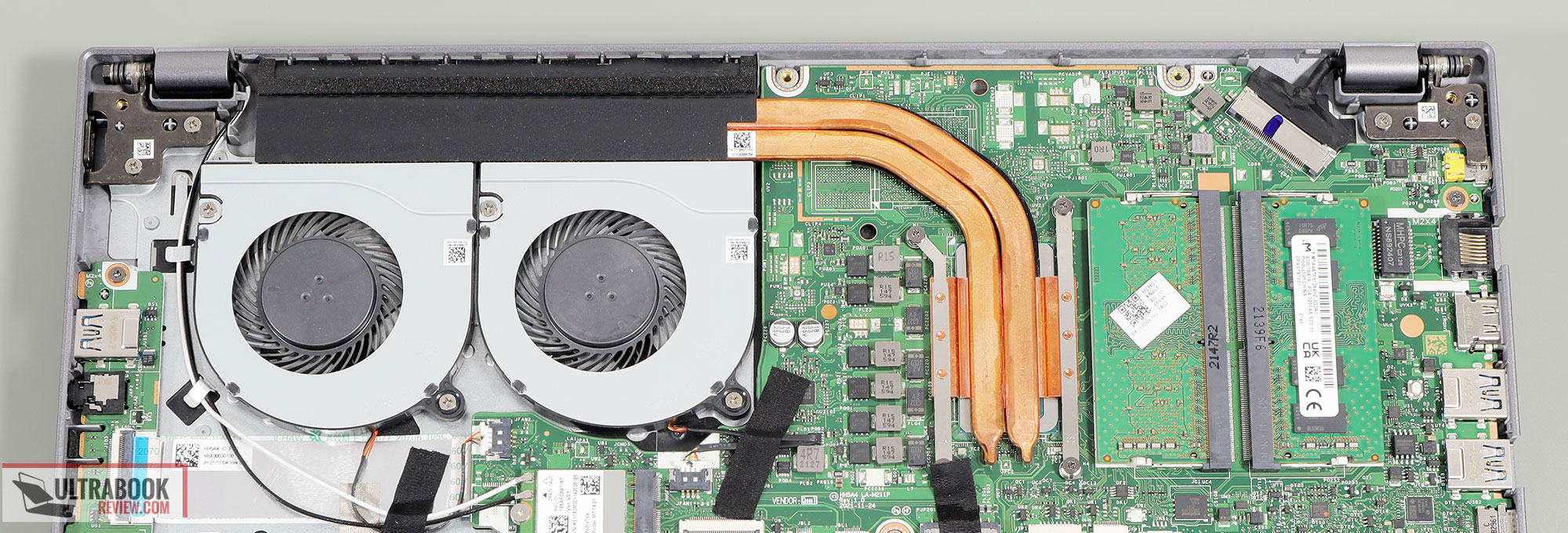
Air comes in mostly through the bottom of the laptop, with the open-grill design, and is pushed out through the radiator positioned in between the hinges.
That means the hot air goes into the screen, but the components are never running hot on this design, and most of the heat is soaked up by the bottom plastic chin. Thus, the panel never gets above high-30s C, so you should not worry about any heat-induced damage here.
In fact, the entire laptop runs mostly cool even with demanding loads, both on the Core U i7+MX550 and on the Core P i3 + Iris Xe models. Of course, the iGPU-only model heats up less.
There is a hotspot on the back of the laptop on the i7+MX550 model, just over the GPU vRAM. That heats up to 55-60 degrees Celsius on my unit, but it doesn’t seem to affect the performance in any way.


*Gaming – playing Dota 2 for 30 minutes, Best Performance mode, fan at ~40 dBA
With daily use, the laptop barely gets warm in some spots despite the fact that the fans keep mostly idle and rarely kick on with multitasking. I did notice some slight electronic creaking on these samples, though, so it’s best to look carefully into this aspect once you receive your unit. Electronic noises are a random issue and can occur in all designs.
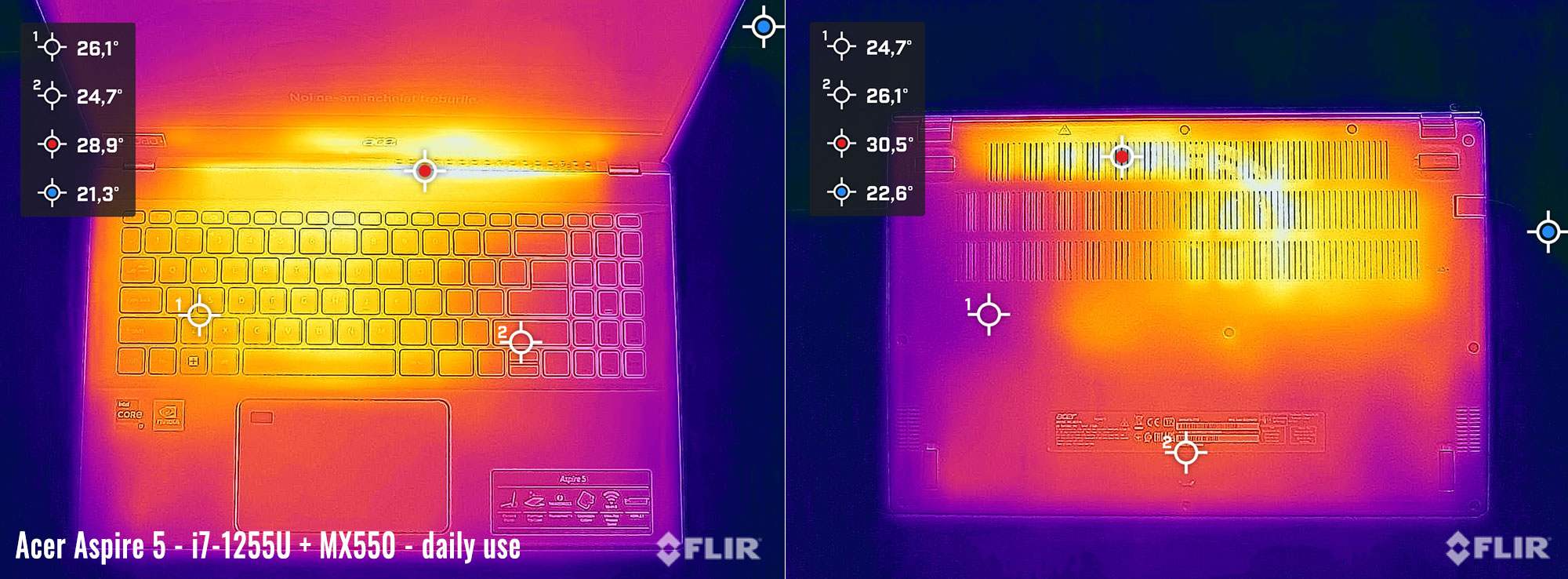
*Daily Use – streaming Netflix in EDGE for 30 minutes, Best Power Efficiency mode, fans 0-30 dBA
For connectivity, there’s WiFi 6E and Bluetooth 5 through a Mediatek module on this laptop. It performed well with our setup and the signal and performance remained strong at 30 feet away from the router, with obstacles in between.
Audio is handled by a set of stereo speakers that fire through grills placed on the underside, which means you should be careful not to cover and muffle them when using the laptop on the lap. The audio quality isn’t much, with very little on the lower-end, as with most Acer Aspire and Swift laptops. It’s fine for some music and movies, but make sure to properly adjust your expectations here.
As for the camera, it’s HD and placed at the top of the screen, but overall washed-out and just poor quality. It’s flanked by microphones, and the two will get the job done for calls, just once more, don’t expect much in image or audio quality.
Battery life
There’s a 50Wh battery inside this Acer Aspire 5, rather small for a full-size laptop by today’s standards, so don’t expect much in terms of runtimes on a charge.
Here’s what we got in our tests, with the screen’s brightness set at around 120 nits (~60 brightness).
- 9 W (~5-6 h of use) – text editing in Google Drive, Best Power Efficiency Mode, screen at 60%, Wi-Fi ON;
- 7.5 W (~7 h of use) – 1080p fullscreen video on Youtube in Edge, Best Power Efficiency Mode, screen at 60%, Wi-Fi ON;
- 6.5 W (~8 h of use) – Netflix FHD fullscreen in Edge, Best Power Efficiency Mode, screen at 60%, Wi-Fi ON;
- 12.5 W (~4-5 h of use) – browsing in Edge, Balanced Mode, screen at 60%, Wi-Fi ON;
- 55 W (-1 h of use) – gaming – Dota 2, Balanced Mode, screen at 60%, Wi-Fi ON.
There are fair results for an Intel platform, so most of you should be fine even with this 50 Wh battery here.
Expect the Core P variants to require a little more energy with basic loads.
Acer pairs the laptop with a compact and lightweight 65W charger that plugs in via a barrel-plug connector. It’s a dual-piece design with long cables. A full recharge still takes over 1.5 hours. You can also plug this in via USB-C, if that’s convenient to you – you’re going to get the same performance with a 65W USB-C charger.

Price and availability- Acer Aspire 5
The Acer Aspire 5 series is widely available in stores in most regions of the world.
I’ve bought my i7-1255U + MX550 model for around 700 EUR over here in Europe, while other models are available for under 600 EUR.
In the US, the i5-1240P + RTX 2050 configuration seems to be the most widespread Aspire 5 A515-57G option, at just shy of $900. Core U models with Iris Xe graphics are also available as the Aspire 5 A515-57, many for under $600.
Various discounts might apply at the time you’re reading the article, so follow this link for updated prices and configurations in your region.
Final thoughts- Acer Aspire 5 A515-57G
This generation of the Aspire 5 refines on its predecessors with a slight update in design and practicality, and a more noticeable update in specs and internal cooling.
Unfortunately, Acer haven’t updated the display in the same manner, and only seem to offer basic-level IPS panels for this series, the kind that might not suffice by today’s expectations. The Audio quality isn’t much here, either.
All in all, though, the Acer Aspire 5 is still a solid contender in its price range, especially in the affordable A515-57 configurations without a dGPU, but also in the MX550 model tested here and widely available in most regions.
The competition in its class are devices like the Asus VivoBook 15, HP Laptop 15, Huawei MateBook D15, the Dell Inspiron 15/16, or the Lenovo IdeaPad 5. We’re also covering a more ample selection of good 15-inch laptops in this separate article.
Let me know what you think of this series and get in touch in the comment section below if you have any questions about it.
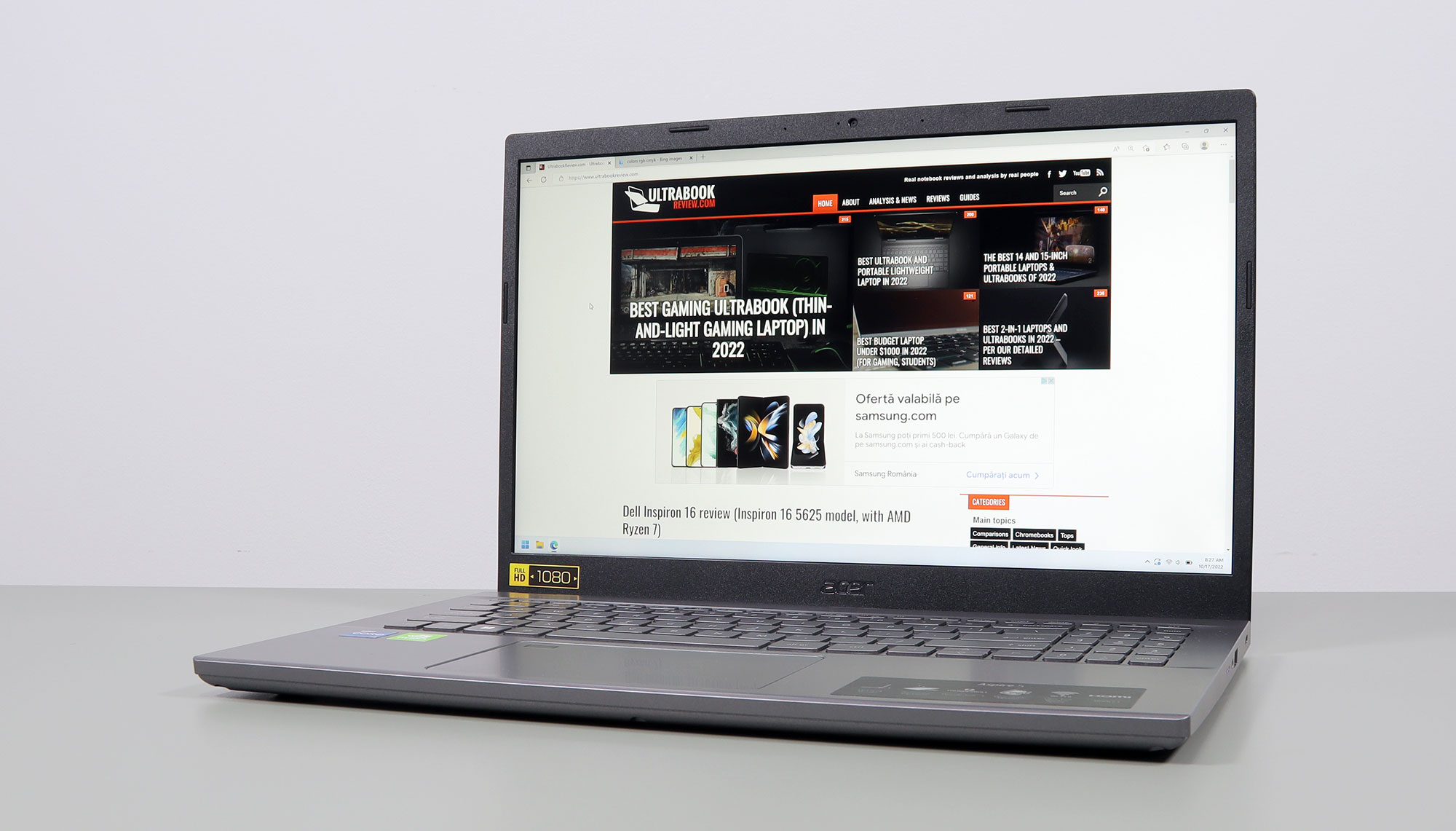
Disclaimer: Our content is reader-supported. If you buy through some of the links on our site, we may earn a commission.
Navigation: Ultrabookreview.com » Acer
Our content is reader-supported. If you buy through some of the links on our site, we may earn a commission. Terms


Review by: Andrei Girbea
Andrei Girbea, Editor-in-Chief. I’ve a Bachelor’s in Computer Engineering and I’ve been covering mobile technology since the 2000s. You’ll mostly find reviews and thorough guides written by me here on the site, as well as some occasional first-impression articles.
. I’ve a Bachelor’s in Computer Engineering and I’ve been covering mobile technology since the 2000s. You’ll mostly find reviews and thorough guides written by me here on the site, as well as some occasional first-impression articles.






